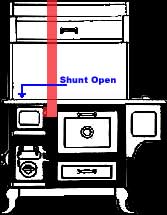Q: Am looking at wood cook stoves on your website and others, and have some questions: my main concern is whether they are user-friendly for
cooking... i.e. how does one adjust the stovetop heat between simmer and high? How does one adjust the heat for baking... does the stove have to
be monitered constantly to keep heat at, say, 350? What about cooking in the summer? Do some brands "perform" better than others?
 When cooking on a wood cookstove, you don't regulate the cooktop or oven temperatures in the same way as you do a conventional gas
or electric range. But that doesn't mean experienced wood cookstove users don't get gourmet results! When cooking on a wood cookstove, you don't regulate the cooktop or oven temperatures in the same way as you do a conventional gas
or electric range. But that doesn't mean experienced wood cookstove users don't get gourmet results!
The only oven control on most wood cookstoves is a shunt that diverts the exhaust from the wood fire through a chamber surrounding the oven. The
shunt is basically an on/off control. When the shunt is open, the wood exhaust goes right out the chimney. When the shunt is closed, the hot exhaust
is redirected so it flows around the outside of the oven, heating the interior to a fairly constant 250-350 degrees. With a little practice, owners of
traditional wood cookstoves learn to adjust their recipes and cooking times to get fantastic results baking within that temperature range. Heating
the oven in this fashion creates the much-desired "brick oven" effect that wood cookstoves are renowned for: all of the oven walls radiate heat
inward at the same time, resulting in even baking and incredible crusts.
script async src="https://pagead2.googlesyndication.com/pagead/js/adsbygoogle.js">
 
A typical wood cookstove's cooking surface incorporates four to six round cookplates. When the fire is going they are all heated to different
temperatures; on a six-burner cookstove, the hottest cookplate is on top of the firebox at left rear, next hottest is on top of the firebox at the front,
then center rear, center front, right rear, and the coolest one is at right front. Cooking temperature is adjusted by sliding the cookware around the
cooktop, onto the appropriate cookplate. With a little practice, extremely precise temperature control can be achieved by using not just the
cookplates but also the areas between. For cooking at very low temperatures, cast iron trivets are used to elevate the cookware above the cooking
surface. Tip: if you have several dishes that need HOT cooktop temperatures, open the oven shunt to increase the temperature on the right side of
the cooktop. The hot smoke traveling across the top of the oven adds a few degrees to the cooktop area above.

Although wood cookstoves are generally thought of as "primitive" appliances, there are a handful of newer designs that incorporate cutting-edge
technology. The best of these, the airtight cookstoves like our Deva 100 model, are much more controllable
than traditional wood cookstoves, as their tight fireboxes and precision draft controls enable you to increase and decrease the
rate of burn inside
the firebox, thus raising and lowering the oven and cooktop temperatures. In this way, ultra-precise cooking temperatures can be maintained for
hours at a time.


Deva 100 |
The fire grate "floor" in the firebox on some models can be adjusted to two positions: the lower (Winter) position
creates a big firebox so you can stoke the fire with large loads of wood to keep a fire going all the time and thus use the cookstove to heat as well as
cook in cold weather, while the upper (Summer) position enables you to build a smaller fire that goes out quickly in warmer weather.
As you can see, cooking on a wood cookstove is very different
than cooking on a conventional kitchen range, and takes some getting used to.
However, once you get the hang of it, you'll find you get amazing results: our customers swear by
their wood cookstoves.
Before taking the wood cookstove plunge, you might want to do a little further reading on the subject: Probably the best-known cookbook for wood
cookstoves is 'Woodstove Cookery: At Home On The Range' by Jane Cooper.
===========================================================================
Copyright © 1996 - 2019 The Chimney Sweep, Inc.
|

